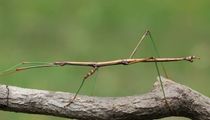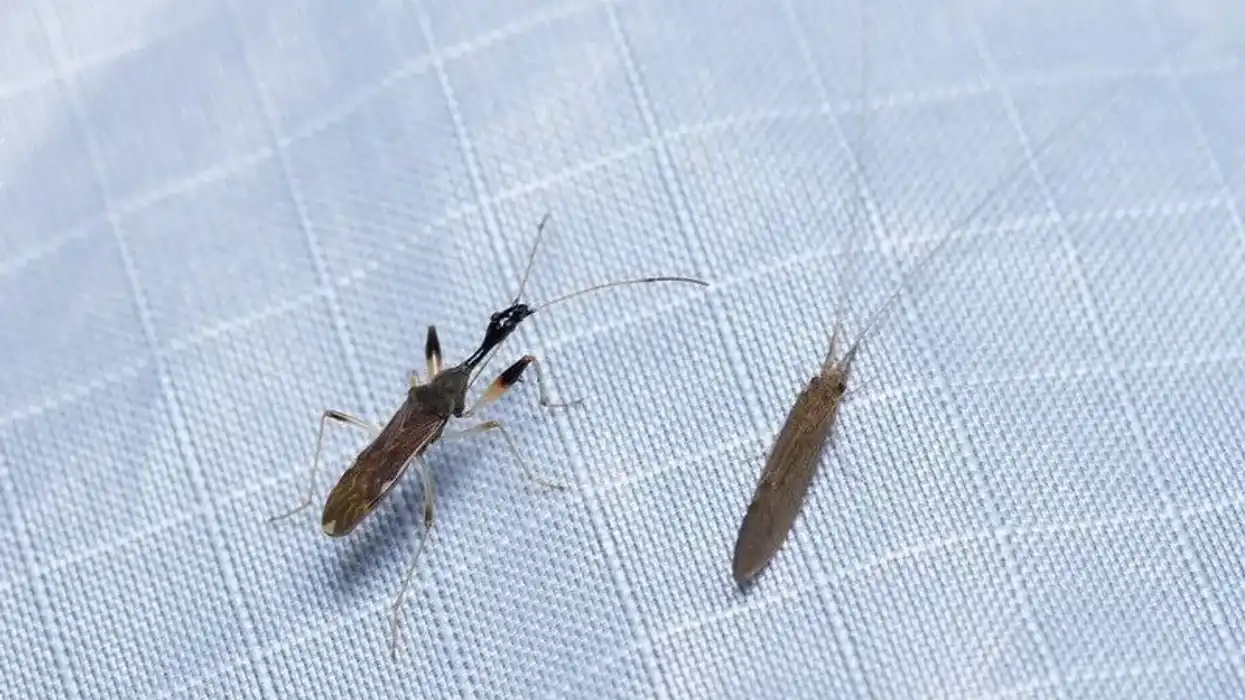The walking leaf is a bug that looks like a stick and appears to resemble a twig. The stick insects protect themselves from their predators, with a very unique camouflage by resembling a twig. They do not bite or sting humans or other insects since they are herbivores.
So is thewalking stick bug poisonous? No, it is not poisonous, and it won't hurt. A walking stick bug's pinch feels like a tiny needle pinch and does not pose any danger to humans.
The stick insects are found worldwide, and yes, they exist on all the continents, except the Antarctic and southern South America.. The Australian Stick Bug, Extatosoma tiaratum, hides from predators by curling up its abdomen towards its head and body.
Some stick insects secrete chemicals using the glands at the front end of their prothorax, They can release odors, and cause stinging or cause a burning sensation to their predators.
The Stick insect is good for the environment. It feeds on the foliage, which may benefit new plant growth. If you love reading these facts about Stick insects, keep going! Find out about the giant water bug and wheel bug too after this one.
Stick Bug Interesting Facts
What type of animal is a stick bug?
As the name implies, the stick bug is an insect that can camouflage itself according to the natural environment like leaf, bark, lichen, twigs, and moss. They are usually brown, but some may be green, black, or gray and change color.
What class of animal does a stick bug belong to?
The stick insects belong to the class Insecta, family Phasmatidae and the stick bug order is Phasmatodea. Walking sticks belong to the same order as Leaf Stick insect species. The African Stick Bug is known as Bactrododema hecticum.
How many stick bugs are there in the world?
There are 3,000 species of stick insects or Walking sticks around the world. According to its habitat, each stick insect species can camouflage and has different physiological characteristics.
Where does a stick bug live?
The stick insects live in the tropical forest, jungles, and woodland. They are found worldwide in Africa, Asia, Europe, Central America, North America, South America, Eurasia, and Oceania. Around 300 Stick insect species are found on Borneo's island.
What is a stick bug's habitat?
The stick bug habitat comprises tropical forests and woodlands. It lives on the leaves of the trees. Often you will find them sitting on the top of the leaves or bark of trees or with mosses and lichens to blend well with the surroundings to protect themselves from being prey.
Most Stick insect species are found in South America, Southeast Asia, and Borneo island (with 300 Stick insect species). The Stick insects are nocturnal and usually come at night to find their prey. The whole day, the Stick insects lie motionless on a plant.
Who do stick bugs live with?
The Stick insects can live on their own or in groups. They are not social creatures to live alone and do not suffer from any loneliness.
How long does a stick bug live?
The Stick insects have an average lifespan of 12 months, but they might live longer if kept in captivity. The Sticks insects go through incomplete metamorphosis. The nymphs or the babies look like the miniature version of the adult Stick insects. In case they have wings, it appears only in the final stage of molting.
How do they reproduce?
The mating behavior of Phasmids is one of the most unique methods. The pairing takes place for extremely long hours. The pairing usually goes on for 79 days. In some other Phasmatodea species, the coupling posture can go on for one or two weeks and some for 136 hours.
The mating of the stick insects is non-stop. During this non-stop coupling session of several days, the Stick insects stick to each other, not letting go of each other. The walking leaf insects do not have visual signals. They rely on the chemicals released in the air to attract their mates.
If the males are absent, the female Stick insects can reproduce without the males' presence. The females can reproduce their young ones from the unfertilized egg. This process is known as parthenogenesis, an asexual form of reproduction. The young ones look exactly like their mother. This parthenogenesis process is a very uncommon phenomenon, and scientists are still studying it.
A single female can lay up to hundred eggs. The stick bug eggs resemble seeds.
As the eggs might be vulnerable to predators, the female Stick insects have various strategies to lay eggs in a safe place to protect them. The females drop each egg on the ground far from one another, or lay eggs in a hiding place or sometimes attach the eggs to the plants' leaves.
The stick insects rely on hemimetabolism (incomplete metamorphosis). The three stages of the Stick Bug life cycle are egg, nymph, and adult stage. Once the baby Stick insects emerge from the eggs, it is known as the nymph stage.
What is their conservation status?
The conservation status of the stick insect is Least Concern to Near Threatened.
Stick Bug Fun Facts
What do stick bugs look like?
The stick insect is a bug that looks like sticks. It is cylindrical, flattened, and leaf-like. It has a slender antenna and compound eyes, long and slender segmented legs, and short or reduced wings. The mouth part comprises the mandibles on both sides. The walking leaf has six legs. There are some species of Stick Bug with wings.
The brown stick bug or the wood stick bug body resembles a stick, branch, or twig. They look so much like twigs that you can't recognize them until they walk away.
It is a thin and slow-moving bug. A few species like the Carausius morosus change their pigments to blend with the surrounding environment. The stick bug camouflage hides them from the predators.
The Stick insects are nocturnal, which means they have excellent vision. They usually go out at night to feed. The eyes comprise facets.
As they grow, the number of facets in the eyes increases, and also the photoreceptor cells are improved. As they develop into adults, their retinal layer adapts to light changes. This retinal layer protects the eyes from radiation.

How cute are they?
The stick insect does not look cute. Its appearance is like that of twigs or dried branches. It is one of the exotic pets you can get home.
How do they communicate?
The Stick insects are known to communicate by releasing chemicals into the air. This is known as chemical communication.Most insect species use this means of communication.
How big is a stick bug?
The average length of a Stick insect is 0.6-25 in (1.5-63 cm) in length. The Giant Stick Bug is 21 in (53.3 cm) in length. The common Stick insect is two times smaller than the Giant Stick insect.
How fast can a stick bug move?
The Phasmids are slow-moving insects. They take only three steps at a time. They walk slower than cockroaches.
How much does a stick bug weigh?
The weight of the stick insect is 0.9-2.3 oz (25-65 g).
What are their male and female names of the species?
The male species is known as the male Stick insect, and the female species is known as the female Stick insect.
What would you call a baby stick bug?
Baby stick insects are called nymphs.
What do they eat?
Stick insects are herbivores. The walking stick bug diet mainly comprises plants and vegetation. The food that Phasmids eat includes leaves, vines, and berries. Since they are nocturnal, they feed at night. The young ones, i.e. the Nymphs, feed on plants, shrubs, and berries.
Are they dangerous?
No, the Stick insects are not dangerous to humans. They are stick-like herbivorous insects who love to hang around vegetation and feed when required. They usually laze around in the daytime and only at night go to find food.
Would they make a good pet?
Yes, the stick insects are kept as pets. They would make a good pet as they are unique and easy to keep.
But you should provide them with spaces with good ventilation and surfaces where they can climb around. As pets, they don't require daily maintenance and can be left alone for days. You can get a stick bug pet through reptile supply vendors.
Did you know...
Have you seen a stick bug dancing? The Stick insects dance to confuse their predators.
The females are larger than the males.
The world's longest insects are Phryganistria chinensis which is 25.2 in (64 cm) in length.
Some stick insects have a mutual relationship with the ants. The ants take the unhatched eggs to their nest, kept safe from predators. After the eggs are hatched, the young Stick insects leave the ants' colony. However, many predators eat the eggs despite the protective measures taken.
Stick bug vs. praying mantis: Like the Mantis, the Stick insect makes rhythmic and side-to-side movements. According to the host plant, the Stick insects will become a stick or leaf. It can also imitate the motion of the twig. It also avoids its predators by remaining motionless and pretending to be dead.
There are some stick bugs with wings. They open their bright-colored wings during a free fall, and once they land, they can camouflage with the ground. Sometimes they display their bright-colored colored wings for up to 20 minutes.
How do stick bugs protect themselves?
The Stick insects camouflage to look like sticks, so the predators cannot identify them. Other ways of protecting themselves from the predators include: changing their color, playing dead, releasing an odor into the air, and swiping with their legs. They can remain motionless for hours.
The Phasmida are known to fight back at a predator with their long legs. Its nocturnal feeding habits also help them to hide from predators. Many Stick insects also like to get rid of their predators by exposing their bright color, which is usually hidden, and making a loud sound.
What do stick bugs do with their skin after they molt?
Every time a stick insect sheds its skin, it means it's growing. Because of its stiff and rigid outer skin, it cannot grow between the cast-off skin. After it sheds off its skin, the Phasmids generally eat their leftover skin. For example, the Extatosoma tiaratum eats its skin after it molts.
Here at Kidadl, we have carefully created lots of interesting family-friendly animal facts for everyone to discover! Learn more about some other arthropods including leaf-footed bug, or western conifer seed bug.
You can even occupy yourself at home by drawing one on our Stick Bug coloring pages.










